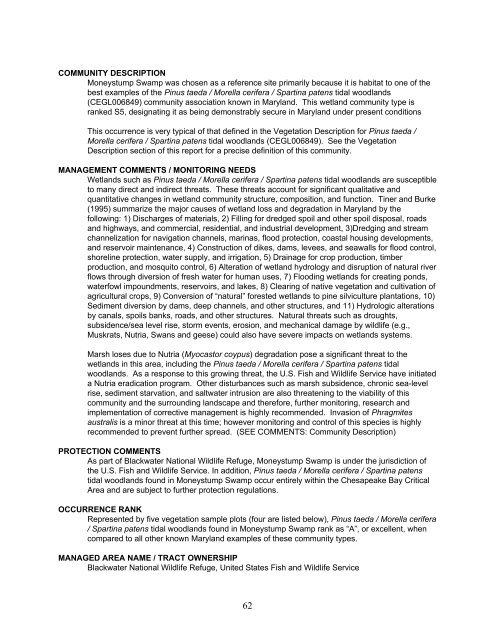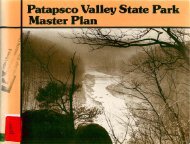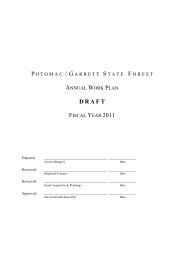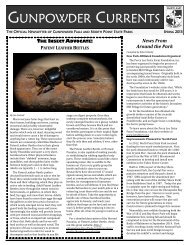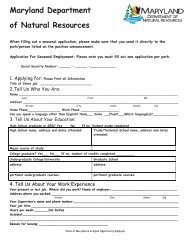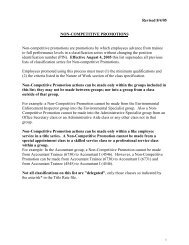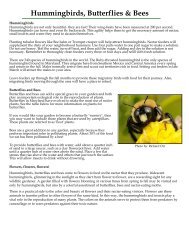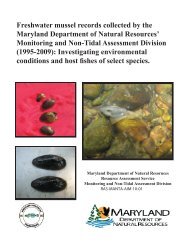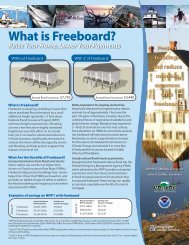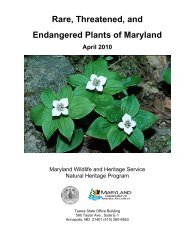tidal hardwood swamps - Maryland Department of Natural Resources
tidal hardwood swamps - Maryland Department of Natural Resources
tidal hardwood swamps - Maryland Department of Natural Resources
You also want an ePaper? Increase the reach of your titles
YUMPU automatically turns print PDFs into web optimized ePapers that Google loves.
COMMUNITY DESCRIPTION<br />
Moneystump Swamp was chosen as a reference site primarily because it is habitat to one <strong>of</strong> the<br />
best examples <strong>of</strong> the Pinus taeda / Morella cerifera / Spartina patens <strong>tidal</strong> woodlands<br />
(CEGL006849) community association known in <strong>Maryland</strong>. This wetland community type is<br />
ranked S5, designating it as being demonstrably secure in <strong>Maryland</strong> under present conditions<br />
This occurrence is very typical <strong>of</strong> that defined in the Vegetation Description for Pinus taeda /<br />
Morella cerifera / Spartina patens <strong>tidal</strong> woodlands (CEGL006849). See the Vegetation<br />
Description section <strong>of</strong> this report for a precise definition <strong>of</strong> this community.<br />
MANAGEMENT COMMENTS / MONITORING NEEDS<br />
Wetlands such as Pinus taeda / Morella cerifera / Spartina patens <strong>tidal</strong> woodlands are susceptible<br />
to many direct and indirect threats. These threats account for significant qualitative and<br />
quantitative changes in wetland community structure, composition, and function. Tiner and Burke<br />
(1995) summarize the major causes <strong>of</strong> wetland loss and degradation in <strong>Maryland</strong> by the<br />
following: 1) Discharges <strong>of</strong> materials, 2) Filling for dredged spoil and other spoil disposal, roads<br />
and highways, and commercial, residential, and industrial development, 3)Dredging and stream<br />
channelization for navigation channels, marinas, flood protection, coastal housing developments,<br />
and reservoir maintenance, 4) Construction <strong>of</strong> dikes, dams, levees, and seawalls for flood control,<br />
shoreline protection, water supply, and irrigation, 5) Drainage for crop production, timber<br />
production, and mosquito control, 6) Alteration <strong>of</strong> wetland hydrology and disruption <strong>of</strong> natural river<br />
flows through diversion <strong>of</strong> fresh water for human uses, 7) Flooding wetlands for creating ponds,<br />
waterfowl impoundments, reservoirs, and lakes, 8) Clearing <strong>of</strong> native vegetation and cultivation <strong>of</strong><br />
agricultural crops, 9) Conversion <strong>of</strong> “natural” forested wetlands to pine silviculture plantations, 10)<br />
Sediment diversion by dams, deep channels, and other structures, and 11) Hydrologic alterations<br />
by canals, spoils banks, roads, and other structures. <strong>Natural</strong> threats such as droughts,<br />
subsidence/sea level rise, storm events, erosion, and mechanical damage by wildlife (e.g.,<br />
Muskrats, Nutria, Swans and geese) could also have severe impacts on wetlands systems.<br />
Marsh loses due to Nutria (Myocastor coypus) degradation pose a significant threat to the<br />
wetlands in this area, including the Pinus taeda / Morella cerifera / Spartina patens <strong>tidal</strong><br />
woodlands. As a response to this growing threat, the U.S. Fish and Wildlife Service have initiated<br />
a Nutria eradication program. Other disturbances such as marsh subsidence, chronic sea-level<br />
rise, sediment starvation, and saltwater intrusion are also threatening to the viability <strong>of</strong> this<br />
community and the surrounding landscape and therefore, further monitoring, research and<br />
implementation <strong>of</strong> corrective management is highly recommended. Invasion <strong>of</strong> Phragmites<br />
australis is a minor threat at this time; however monitoring and control <strong>of</strong> this species is highly<br />
recommended to prevent further spread. (SEE COMMENTS: Community Description)<br />
PROTECTION COMMENTS<br />
As part <strong>of</strong> Blackwater National Wildlife Refuge, Moneystump Swamp is under the jurisdiction <strong>of</strong><br />
the U.S. Fish and Wildlife Service. In addition, Pinus taeda / Morella cerifera / Spartina patens<br />
<strong>tidal</strong> woodlands found in Moneystump Swamp occur entirely within the Chesapeake Bay Critical<br />
Area and are subject to further protection regulations.<br />
OCCURRENCE RANK<br />
Represented by five vegetation sample plots (four are listed below), Pinus taeda / Morella cerifera<br />
/ Spartina patens <strong>tidal</strong> woodlands found in Moneystump Swamp rank as “A”, or excellent, when<br />
compared to all other known <strong>Maryland</strong> examples <strong>of</strong> these community types.<br />
MANAGED AREA NAME / TRACT OWNERSHIP<br />
Blackwater National Wildlife Refuge, United States Fish and Wildlife Service<br />
62


